AMD Kaveri Review: A8-7600 and A10-7850K Tested
by Ian Cutress & Rahul Garg on January 14, 2014 8:00 AM ESTIntegrated GPU Performance: BioShock Infinite
The first benchmark in our test is Bioshock Infinite, Zero Punctuation’s Game of the Year for 2013. Bioshock Infinite uses the Unreal Engine 3, and is designed to scale with both cores and graphical prowess. We test the benchmark using the Adrenaline benchmark tool and their three default settings of Performance (1280x1024, Low), Quality (1680x1050, Medium/High) and Xtreme (1920x1080, Maximum) noting down the average frame rates and the minimum frame rates.
Bioshock Infinite, Performance Settings
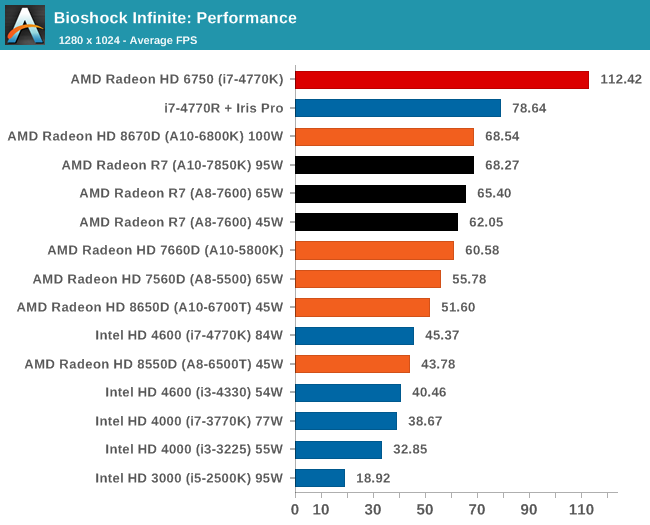
For BI: Performance we see the Iris Pro being top of the IGPs, although the next six in the list are all AMD. The Kaveri cores are all between the 6800K and 5800K for this test, and all comfortably above 60 FPS average.
Bioshock Infinite, Quality Settings

For the quality settings, the Iris Pro starts to struggle and all the R7 based Kaveri APUs jump ahead of the A10-6800K - the top two over the Iris Pro as well.
Bioshock Infinite, Xtreme Settings
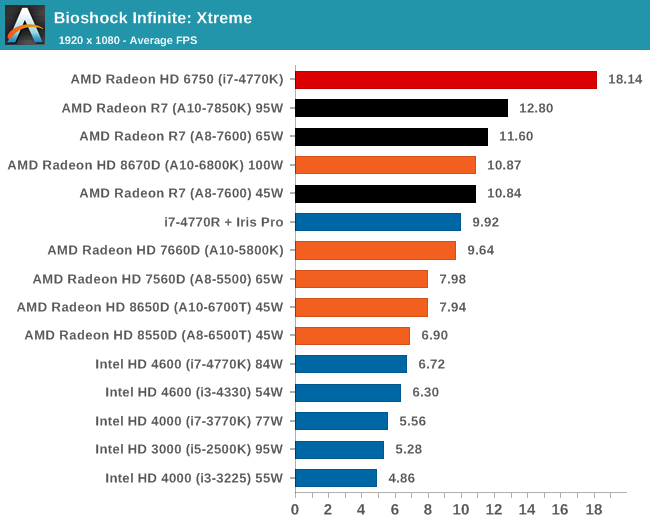
The bigger the resolution, the more the Iris Pro suffers, and Kaveri takes three out of the top four IGP results.
Integrated GPU Performance: Tomb Raider
The second benchmark in our test is Tomb Raider. Tomb Raider is an AMD optimized game, lauded for its use of TressFX creating dynamic hair to increase the immersion in game. Tomb Raider uses a modified version of the Crystal Engine, and enjoys raw horsepower. We test the benchmark using the Adrenaline benchmark tool and their three default settings of Performance (1280x1024, Low), Quality (1680x1050, Medium/High) and Xtreme (1920x1080, Maximum) noting down the average frame rates and the minimum frame rates.
Tomb Raider, Performance Settings
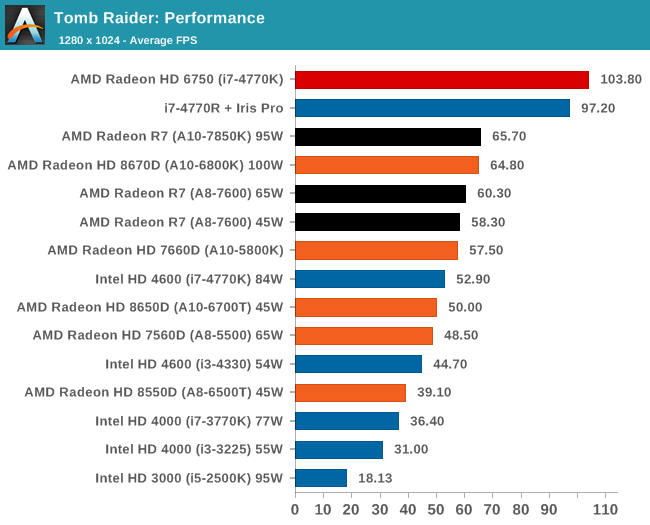
The top IGP for Richland and Kaveri are trading blows in TR.
Tomb Raider, Quality Settings

The Iris Pro takes a small lead, while the Kaveri 95W APU show little improvement over Richland. The 45W APU however is pushing ahead.
Tomb Raider, Xtreme Settings
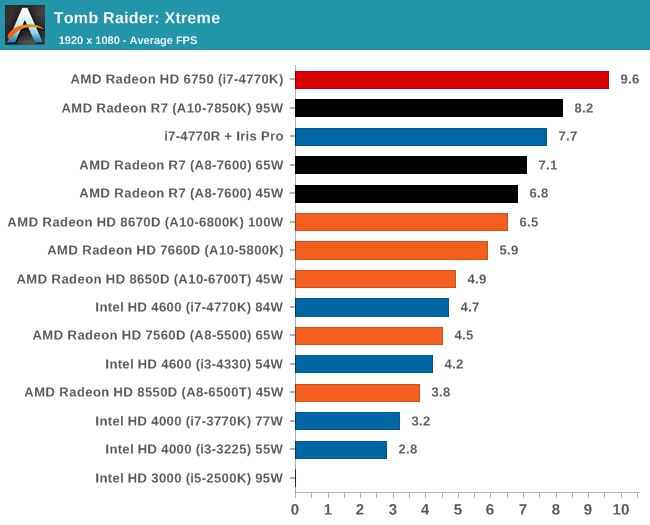
At the maximum resolution, the top Kaveri overtakes Iris Pro, and the 45W Kaveri it still a good margin ahead of the A10-6700T.
Integrated GPU Performance: F1 2013
Next up is F1 2013 by Codemasters. I am a big Formula 1 fan in my spare time, and nothing makes me happier than carving up the field in a Caterham, waving to the Red Bulls as I drive by (because I play on easy and take shortcuts). F1 2013 uses the EGO Engine, and like other Codemasters games ends up being very playable on old hardware quite easily. In order to beef up the benchmark a bit, we devised the following scenario for the benchmark mode: one lap of Spa-Francorchamps in the heavy wet, the benchmark follows Jenson Button in the McLaren who starts on the grid in 22nd place, with the field made up of 11 Williams cars, 5 Marussia and 5 Caterham in that order. This puts emphasis on the CPU to handle the AI in the wet, and allows for a good amount of overtaking during the automated benchmark. We test at three different levels again: 1280x1024 on Low, 1680x1050 on Medium and 1920x1080 on Ultra. Unfortunately due to various circumstances we do not have Iris Pro data for F1 2013.
F1 2013, Performance Settings
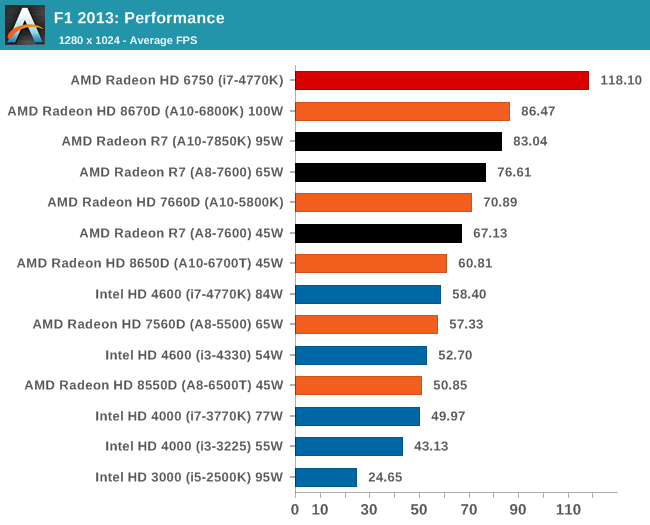
F1 likes AMD here, although moving from Kaveri to Richland at the high end seems a bit of a regression.
F1 2013, Quality Settings
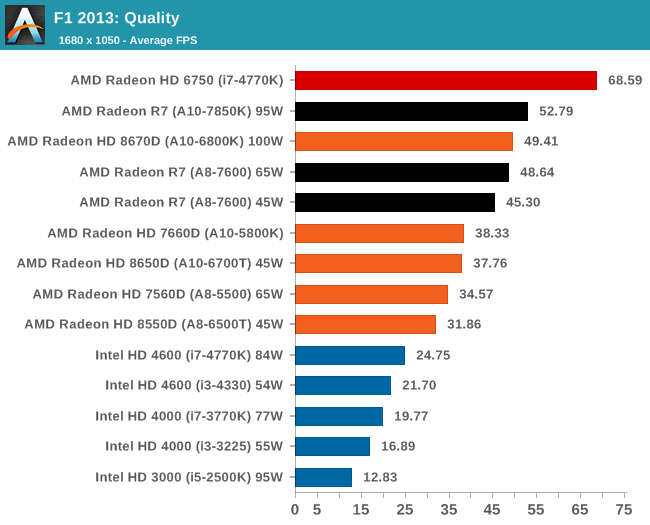
Similarly in the Quality settings, none of the Intel integrated graphics solutions can keep up with AMD, especially Kaveri.
F1 2013, Xtreme Settings

On extreme settings, at 1080p, the top Kaveri APU manages to hit over 30 FPS average during the benchmark. The other A8 Kaveri data is not too far behind.










380 Comments
View All Comments
nader_21007 - Saturday, January 18, 2014 - link
Can you show me what improvement haswell did over previous gen? TDP going from 77W to 84W, meanwhile performance droped in most cases. Can't you see the charts in this review?Principle - Tuesday, January 14, 2014 - link
Andrew, that depends based on size, budget, etc...and I own an AMD Piledriver CPU and could never tell you when it was supposedly slower, maybe a game takes a couple seconds longer to load, but after that its all the same.And I have used Intel CPUs too, and have hiccups and lag multitasking with them in real life, that never happens on my AMD systems. If you get an i5 and an AMD GPU, that would be great and last with the GPU compute advantage of AMD GPUs and the Mantle potential.
These Kaveri have a lot of value at launch for the entertainment center PCs, or ITX platforms because at 65W or even 45W it delivers a lot of performance in one chip that you can keep cool and quiet in a small package. Also good for all in one PCs built into the monitor. Not for the avid gamer right now, but a little more future proof than an Intel CPU in my opinion.
ImSpartacus - Thursday, January 16, 2014 - link
If you're not gaming, is it really that hard to "future-proof" your CPU?I feel like most low end CPUs will perform "basic" non-gaming tasks for many years to come.
andrewaggb - Tuesday, January 14, 2014 - link
To be clear, I'd get an i5 quad core with a 260x or 270x. I realize they aren't at all in the same price range, but it's good performance per dollar.I was expecting Kavari to have 10% better cpu performance and 25% better gpu performance. This has equal cpu performance and essentially equal gpu performance. It has other improvements, but that's a serious dissappointment on the performance side of things.
I've already got 3 i5 quad cores with a 6870, 7850, and 270x in each and I'm happy with them. Just though Kaveri might be good enough, and it is for older stuff and minecraft and whatnot.
But it seems like yet another year that paying the extra money and having some longevity is going to be the right move.
Quite frankly my oldest system, the i5 750 with a 6870 would mop the floor with kaveri in everything but power consumption.
yankeeDDL - Wednesday, January 15, 2014 - link
You're kidding right?It practically doubled the performance per watt of Richland (45W Kaveri almost always outpaces 100W Richland) and that's disappointing?
It's true that Richland was way behind, but the improvement is massive.
There's still a glaring gap with Intel's CPU, but it is smaller.
Just as much as the glaring gap on the GPU side (but this time on AMD's favor) got wider.
HSA is the key for AMD to push the GPU advantage over to the CPU to compensate. If it works, then Kaveri will be really up to, or better of the core I5 which cost more than 2X ... "IF" ...
Jaybus - Thursday, January 16, 2014 - link
I'm not convinced HSA is the future. It is a diminishing returns issue. The only difference between HSA and SMP is different types of cores are being used. The bus arbitration and coherency issues are exactly the same. Neither is scalable to dozens of cores, let alone hundreds. HSA has the same limitations as SMP. Something like Knights Corner's ring bus and message passing is more likely the future. Near term, there is an advantage to HSA. Long term will rely on a much faster chip-to-chip interconnect to transfers and segmented memory to avoid the arbitration and coherency issues. CMOS silicon photonics maybe. That would enable optical busses orders of magnitude faster than PCIe, or in fact much faster than any chip-to-chip electronic bus, and that would make something like Knights Corner's ring bus the future path to high core counts.jimjamjamie - Thursday, January 16, 2014 - link
A genuinely interesting and insightful comment, thanks.artk2219 - Tuesday, January 14, 2014 - link
Until you play a game that uses more than 2 threads, or have tasks running in the background while gaming, then you'll wish you had those two extra threads. Seriously I wish people would quite trying to recommend dual cores for gaming or even general use, unless its in a machine for the type of person that only does one or two things thing at a time. Dual cores are showing their age now, its only going to be worse a year or two from now. Also why would you spend 90 on a Pentium dual core when you could spend 80 on an Athlon 750k or that same 90 on a 760k. They have similar single thread performance and stomp the g2120 in multithreaded situations, plus they're unlocked so you can overclock to your hearts content. Im not saying that Kaveri isn't overpriced right now, they could stand to drop 20 dollars for the top two chips and 10 for the last chip reviewed. But they just launched and those prices will change, and in the end its easier to point people to one part for all of their needs than it is to point them to two.http://www.newegg.com/Product/ProductList.aspx?Sub...
Nagorak - Wednesday, January 15, 2014 - link
The Intel processors are more energy efficient. That's one reason.artk2219 - Wednesday, January 15, 2014 - link
Fair enough, but its a negligible difference once you factor in the discrete GPU that you would be pairing it with anyways. Cooling it shouldn't be anymore of a problem than cooling the same setup with the DGPU, granted there aren't really any fm2+ itx boards so that may be a problem if you're going for a tiny size, but thats about it.